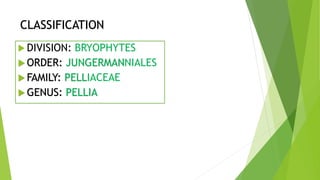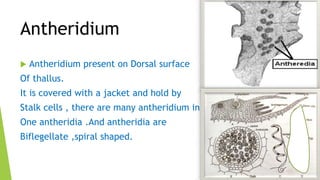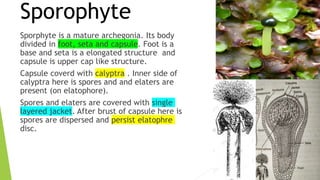PELLIA LIFE CYCLE
- 2. CLASSIFICATION DIVISION: BRYOPHYTES ORDER: JUNGERMANNIALES FAMILY: PELLIACEAE GENUS: PELLIA
- 3. Jungermaniales divided in two groups Anacrogynus Acrogynus Pellia comes in anacrogynus REASON :- ARCHEGONIA BORN ON THE DORSAL SURFACE OF THE PROSTRATE SHOOT. APICAL CELL ARE NOT INVOLVED IN THE FORMATION OF ARCHEGONIA.
- 4. MORPHOLOGY Simple prostrate thallus. Only smooth rhizoids present. Dichotomously branched. Mid rib but no scales. Mucilage hairs on growing tip. Green thallus. Thin thallus but thick on mid rib.
- 5. ANATOMY thalluls contain Parenchymatous cells. Both side of epidermis present. Fiberous cells present. Chloroplast present. Antheridium on dorsal side hold with stalk cells.
- 6. Antheridium Antheridium present on Dorsal surface Of thallus. It is covered with a jacket and hold by Stalk cells , there are many antheridium in One antheridia .And antheridia are Biflegellate ,spiral shaped.
- 7. Archegonia Archegonia found in clusters form. Cover with involucre. Mature archegonia contain to egg. Before furtilization neck wall is single layered . After fertilization archegonia changed into sporophyte capsule and hanging on air.
- 8. Sporophyte Sporphyte is a mature archegonia. Its body divided in foot, seta and capsule. Foot is a base and seta is a elongated structure and capsule is upper cap like structure. Capsule coverd with calyptra . Inner side of calyptra here is spores and and elaters are present (on elatophore). Spores and elaters are covered with single layered jacket. After brust of capsule here is spores are dispersed and persist elatophre disc.
- 9. Thank you








